Boo Who?: Mystic Pizzazz, Ghost Writing and Arrant Spelling
Strange Powers, July 19 – September 17, 2006
curated by Laura Hoptman and Peter Eleey
produced by Creative Time
at 64 East Fourth Street, second floor
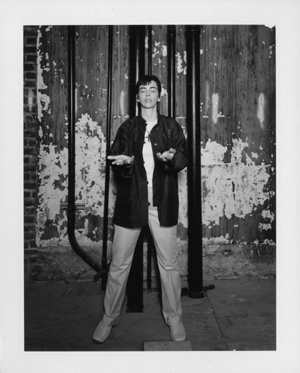
In 1983 I curated a group exhibition called Totem, with work from fifty artists filling three galleries in the 420 West Broadway building in SoHo. The show dealt with figurative imagery and, without going into any particular detail, conflated the (then) predominant school of Neo Expressionism with l’école de East Village painting. In her Voice review, Lucy Lippard called it "intellectual Halloween". This was not meant as a compliment.
Totem itself is long gone, as are two of its host galleries (the third moved to Chelsea). The memory of the show is dim and fading, but the epithet endures. "Intellectual Halloween" again came to mind when I viewed Strange Powers, Creative Time’s current group spook-a-thon, summer séance and assembly of the contemporary art coven. A show of crystal balls, magic wands, things that go bump, darkened rooms, voices from beyond, and investigations into the paranormal, its inherent theatricality is heightened, or at least highlighted, by its chosen site: an actors’ rehearsal loft on East Fourth Street above the main stage of Tom Noonan’s Paradise Theater.
Here, in the off-off Broadway Neverland of a non profit theater, which is reported to be haunted (perhaps by the ghosts of unemployed actors, who have plenty of time to do spooky voice overs), Creative Time attempts to cast its itinerant spell.
When Marshall McLuhan said the medium is the message, he was not, to my knowledge, referencing an actual spiritual clairvoyant. But who knows? TV is certainly a voice (and image) from the beyond. Think how many recent horror films use the device of an evil spirit emanating from the TV screen (The Ring, Videodrome, etc.)
McLuhan was a social scientist. Art is not a science. Perhaps that’s why we call it art. But art can appropriate the look of science, and certainly of pseudo science. Art can revel in fashionable superstition, taken from mass cultural forms such as airport novels, movies and TV. (I’m thinking X-Files, but name your own poison.) As a "high" form, art can be made more democratic and cool, and can borrow interest, by incorporating ectoplasmic reveries from the popular imagination, of street corner theosophy. The garden of the hyperreal readily yields to the slough of the paranormal. Madame Blavatsky, are you there? Give us a sign.
In fact, art is eminently positioned to confront the occult. The usual adjectives addressing the artistic process already acknowledge its "strange powers." Art is magic. It is intuitive. It is transformative, alchemical. It provides a door to an alternate consciousness. As Bruce Nauman noted in his famous spiraling neon sign from 1967: "The True Artist Helps the World by Revealing Mystic Truths."

Kind of says it all, doesn’t it? And with a mudra that shapes his mantra. This was just three years before Robert Smithson executed Spiral Jetty. Was there something in the air? Certainly there was a tendency in postminimalism, conceptualism and Arte Povera -- work from the late 60s through the early 70s – to reach out towards the ineffable, to give shape or direction to the incorporeal, to deal with ritual and performance, to deconstruct the existence of the object while stressing its essence.
In the wake of Nauman’s deadpan elegance, precision and brilliant brevity – which continued in his future work, although nothing by him is included in Strange Powers -- any further investigation into the mystical or magical purposes of art might seem redundant, if not presumptuous. But that never stopped curators from stretching their muscles, if the spirits so moved them. As recently as December 2005, the Metropolitan Museum hosted The Perfect Medium: Photography and the Occult. The Philadelphia ICA presented The Big Nothing in summer 2004, devoted to the immaterial and evanescent in contemporary art. An exhibition called Spiritus, at Magasin 3 in Stockholm in 2003, dealt with art and its relation to séance imagery.
There are, of course, many more examples of this curatorial fixation, each with its own particular take on the mystical, the spiritual or the paranormal. Some find it in abstract painting, some in photography, some in performance or video, some in sculpture or relics. Some in spoken word, whether or not it emanates from the crypt. In assembling their particular Wunderkammer, their chamber of eldritch curiosities, the curators of Strange Powers – Laura Hoptman of New Museum and Peter Eleey from Creative Time – seem determined to eschew any one point of view, incorporating works which range widely by subject, medium and practitioner.
There is strength in casting the net wide – it guarantees a survey – but also the danger of abandoning focus, of dilettantism, of assembling a sloppy conglomeration filled with the usual suspects. What I would call group-itis, which allows for the old and (mostly) the new, the quick (to schmooze) and the (well reputed) dead, the borrowed and the (gothic black and) blue. Twenty-one artists (or artist groups) in all.
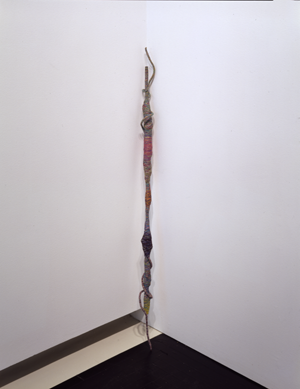
First, the props. Could a show called "Strange Powers" be complete without a magic wand or crystal ball? Jim Lambie is almost as well known for his psychedelic power sticks as for his taped floors, wrapping bamboo staves in thread, cloth, wire and other common materials for a jolt of mojo in the mundane. One of his wands is suspended in a vitrine, seemingly floating in mid air. How does it do that? Hocus pocus or monofilament?
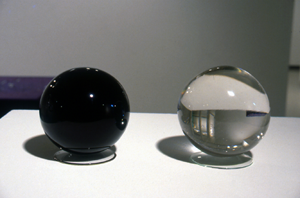
Eva Rothschild offers not one but two glass orbs displayed on a plinth, seemingly ready for divination, or bowling. One is crystal clear, the other murky black. The good, the bad, and the chiaroscuro? I stared at them for a while, waiting for an image or revelation to take shape within. Nothing. But like Rothschild’s metal sculptures, these orbs seem to be harnessing the lessons of minimalism for a "new age".
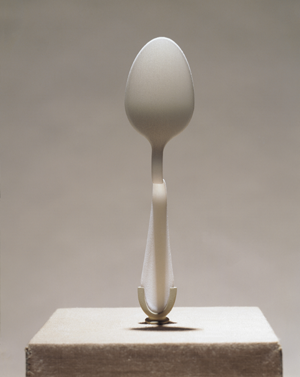
In a nod to Uri Geller and the film Poltergeist, Paul Pfeiffer presents a bent spoon, housed like a relic under glass. It is an early piece (2001) and blends well with his better known media appropriative videos. Interestingly, due not to psychic forces but to the old, warped flooring of the building, the spoon would visibly vibrate whenever anyone walked near it. But why bend spoons and not forks or knives, oh unhappy spirit? Wasn’t there room under the glass for an entire place setting, or for a basketball spinning at the end of a hundred NBA inspired fingers? Now THAT particular video by Pfeiffer WAS indeed magic!

Several works had previous lives in other exhibitions and were resurrected for Strange Powers. The most notable, perhaps, is "The Ghost of James Lee Byars", a pitch black room (sealed behind double curtains at both entry and exit, to prevent even a single ray of light from entering) which the eponymous artist created in 1969 to house his ghost, when appropriate. As Byars passed away in 1997, it would seem a propitious moment.

Byars was an aesthete and an art dandy, and employed a particularly charged alchemy of materiality and shape, and a hieratic sense of performance. Gold leaf, blown glass and a black top hat figured symbolically in his work, which combined elements of eastern mysticism and Fluxus. There was a three gallery posthumous retrospective of his work in NY this spring, which followed an exhibition at the Whitney. Whether or not you sense his ghost in the chamber, or the ghost of Christmas past, is entirely up to you. But it is certainly very, very dark in there.
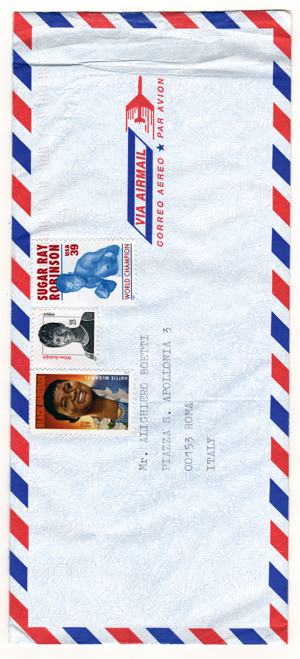
Also brought back for a return engagement is Jonathan Monk’s set of six letters to Alighiero E Boetti, the Italian artist and mystic who died in 1994. As was done when the piece was previously exhibited, all the letters were mailed to Boetti’s last known address in Rome. Of the current batch, only one has been returned as undeliverable. Did the others wind up in some spiritual way station? Were they in fact forwarded to the artist at his new, postmortem address? Or have they merely been lost, incorrectly filed or otherwise mishandled by the Italian postal system? How much does circumstance and accident feed into our acceptance of magic – or do we hold out for a definite, empirical proof which might never come?
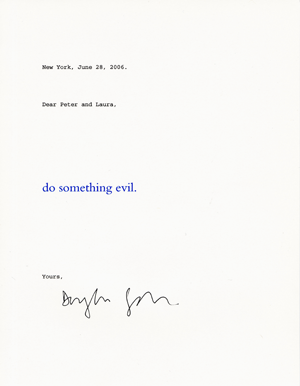
Douglas Gordon once participated in a show in LA (in 1997) by sending a letter to the curators there, urging them to "do something evil." He reprised this letter to the curators of Strange Powers, who responded by having a curse placed on a tube of black paint, which was then used to create a rectangle on the wall, over which Gordon’s framed letter is mounted, as if to mediate, mitigate or absorb the evil. Gordon currently has a retrospective up at MoMA. Had I seen him at Strange Powers, I might have asked whether he referenced another letter enjoining him to "do something interminable", which led him to make 24 Hour Psycho.
Workers of the paranormal world unite! You have nothing to clank but your chains! Strange Powers would be incomplete without some homage to the workaday psychics, healers and clairvoyants who ply their arcane trade in this world or the next. Or somewhere in between.
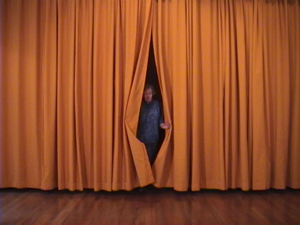
Euan Macdonald is represented by the projected video of a woman who enters through an orange curtain, clasps her hands together, stands alone and still with a mild, direct gaze for about four minutes, and then disappears from whence she came, behind the curtain. She is middle-aged and self possessed, even a bit dowdy in her loose fitting blue ensemble. The piece is called "Healer," and apparently the woman is just that, a psychic healer from New Zealand.
We cannot help but reflect on the significance of her (otherwise unremarkable) gaze and posture. Is this the face of psychic renewal? Was there some actual healing going on as we watched? Of course, were it entitled "Housewife", it might trigger a whole different set of responses. These are the ambiguities of perception and deception that color Macdonald’s work. The piece is also up in Times Square, as part of Creative Time’s 59th Minute series.
Photographer Miranda Lichtenstein invited a psychic named Sondra Shaye to enter the loft prior to the installation of the show and clear it of all negative vibes and associations. To make it safe for art, as it were. Lichtenstein photographed this act of spiritual cleansing, and exhibits a photo of the performance, which combines a sense of documentary with the implication of transcendence (see image at the top of this review). And while Shaye looks quite capable of neutralizing the unrequited spirits of snubbed actors, I might doubt her abilities when up against that swatch of cursed black paint.
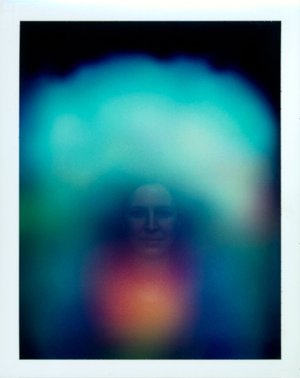
Certain powers are especially useful within the subculture of the art world. Anne Collier seems to have participated in half the NYC group shows of 2006, particularly since her inclusion in the Whitney Biennial. What abstruse incantation does she use to enchant and enslave the curatorial will? Many fellow artists are dying to find out. If not paranormal, her omnipresence is certainly super normal.
Does she in fact suffer from overexposure? Not in the photographic sense: her images of piles of magazine and record album covers are generally crisp, arch and conceptual. But the Aura Photographs shown here are a bit different, products of a specially modified Polaroid camera that can be found in specially stores dealing with the psychic and supernatural, with associated paraphernalia like metal sensor strips and computer printouts hooked up to the camera. When artist friends (including John Baldessari) visited her studio while she was still living in California, Collier brought them to the store and had these photos done. They purport to reveal the inner state of the sitter rather than any outward, objective appearance. In addition to their pseudo scientific claims of mapping an inherent spiritual energy, the Aura Photographs graze the edge of abstraction.
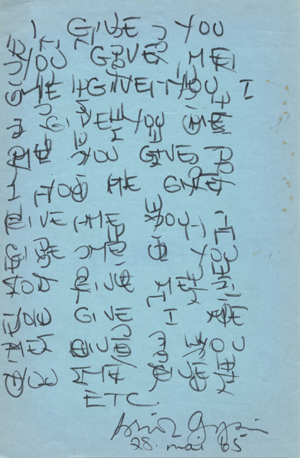
Spells are not just spoken incantations. They also have a written, calligraphic identity that was central to the life and work of Brion Gysin (1916 - 1986), the beat poet, expatriate, Sufi adept, and longtime companion of William Burroughs. Together with Burroughs, he developed the fold-in and other textual devices to enhance or alter literary creativity.
Gysin lived much of his life in Tangier and in the Mediterranean, where he was a student of the Kabbalah and other paths that stressed ritual, magic and inscription. The drawing above, reputedly written under the influence of LSD, has letters going both backwards and forwards, a method typically used in spells and ancient alphabets like Boustrophedon (literally "as the ox plows" in Greek), where successive lines were alternately inscribed left to right and then right to left.
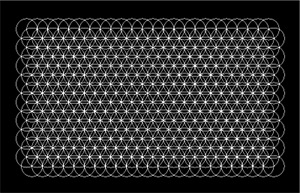
Peter Coffin also delves into the power of inscription. His series of interlocking circles seems to inhabit a middle ground between mechanical drawing and the ritualized channeling of thought, energy and attention. In other words, magic. As an adjunct to this drawing, there is a tub of pastel colored chalk on the front desk. When visitors ask about the work, the gallery attendant is empowered to draw a chalk circle around them on the wooden floor. This enclosure – by pentagram, circle or other geometric device (drawn by chalk on the floor or a stick in the dirt) -- is a common magical practice, meant to isolate the individual, either as protection from the evil without or to isolate the energy within. As Strange Powers continues its run, the chalk circles are meant to proliferate, intersect and overlap, mirroring the density of inscription in the drawing on the wall.
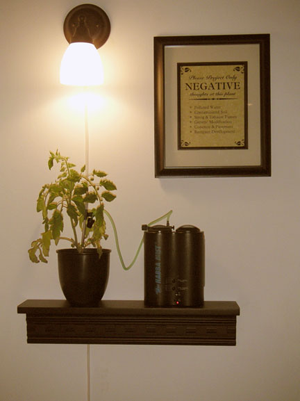
The Center for Tactical Magic is a San Francisco based collective that attempts to harness latent psychic energy to promote the social good. Their installation, "Vital Psigns", investigates the telepathic connection between humans and plants. Viewers are asked to focus positive and negative thoughts on three similar potted plants (the middle one, a control, is supposed to be ignored). The results are as expected: the plant subjected to positive vibes flourishes, while the "negative" one withers.
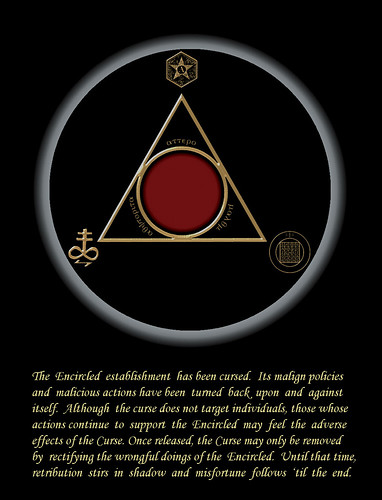
In addition, they are distributing DIY Hex stickers at the front desk. Viewers are encouraged to envision a particular organization or corporation that perpetuates a social or political ill, write the name of that organization in the red circle in the center of the sticker, and affix the sticker to the property of that entity – which will then be cursed. In a notable reversal, the second time I came by to view the show, someone had affixed a sticker to the gallery door after writing the words "Creative Time" inside the red circle, thus effectively cursing the exhibition, if not the entire organization. Which provides us with a final cautionary lesson: that no one is immune from judgment, that magic is a two way street, and that the "strange powers" it unleashes can entwine both practitioner and recipient.
My apologies to Joachim Koester, Sophie Calle, Trisha Donnelly, and those few others whose contributions I was unable to discuss due to constraints of space and time. Their work, like everything else in Strange Powers, can be viewed from 4 – 7 pm on Thursday and Friday, noon – 7 pm on Saturday and Sunday.
curated by Laura Hoptman and Peter Eleey
produced by Creative Time
at 64 East Fourth Street, second floor

In 1983 I curated a group exhibition called Totem, with work from fifty artists filling three galleries in the 420 West Broadway building in SoHo. The show dealt with figurative imagery and, without going into any particular detail, conflated the (then) predominant school of Neo Expressionism with l’école de East Village painting. In her Voice review, Lucy Lippard called it "intellectual Halloween". This was not meant as a compliment.
Totem itself is long gone, as are two of its host galleries (the third moved to Chelsea). The memory of the show is dim and fading, but the epithet endures. "Intellectual Halloween" again came to mind when I viewed Strange Powers, Creative Time’s current group spook-a-thon, summer séance and assembly of the contemporary art coven. A show of crystal balls, magic wands, things that go bump, darkened rooms, voices from beyond, and investigations into the paranormal, its inherent theatricality is heightened, or at least highlighted, by its chosen site: an actors’ rehearsal loft on East Fourth Street above the main stage of Tom Noonan’s Paradise Theater.
Here, in the off-off Broadway Neverland of a non profit theater, which is reported to be haunted (perhaps by the ghosts of unemployed actors, who have plenty of time to do spooky voice overs), Creative Time attempts to cast its itinerant spell.
When Marshall McLuhan said the medium is the message, he was not, to my knowledge, referencing an actual spiritual clairvoyant. But who knows? TV is certainly a voice (and image) from the beyond. Think how many recent horror films use the device of an evil spirit emanating from the TV screen (The Ring, Videodrome, etc.)
McLuhan was a social scientist. Art is not a science. Perhaps that’s why we call it art. But art can appropriate the look of science, and certainly of pseudo science. Art can revel in fashionable superstition, taken from mass cultural forms such as airport novels, movies and TV. (I’m thinking X-Files, but name your own poison.) As a "high" form, art can be made more democratic and cool, and can borrow interest, by incorporating ectoplasmic reveries from the popular imagination, of street corner theosophy. The garden of the hyperreal readily yields to the slough of the paranormal. Madame Blavatsky, are you there? Give us a sign.
In fact, art is eminently positioned to confront the occult. The usual adjectives addressing the artistic process already acknowledge its "strange powers." Art is magic. It is intuitive. It is transformative, alchemical. It provides a door to an alternate consciousness. As Bruce Nauman noted in his famous spiraling neon sign from 1967: "The True Artist Helps the World by Revealing Mystic Truths."

Kind of says it all, doesn’t it? And with a mudra that shapes his mantra. This was just three years before Robert Smithson executed Spiral Jetty. Was there something in the air? Certainly there was a tendency in postminimalism, conceptualism and Arte Povera -- work from the late 60s through the early 70s – to reach out towards the ineffable, to give shape or direction to the incorporeal, to deal with ritual and performance, to deconstruct the existence of the object while stressing its essence.
In the wake of Nauman’s deadpan elegance, precision and brilliant brevity – which continued in his future work, although nothing by him is included in Strange Powers -- any further investigation into the mystical or magical purposes of art might seem redundant, if not presumptuous. But that never stopped curators from stretching their muscles, if the spirits so moved them. As recently as December 2005, the Metropolitan Museum hosted The Perfect Medium: Photography and the Occult. The Philadelphia ICA presented The Big Nothing in summer 2004, devoted to the immaterial and evanescent in contemporary art. An exhibition called Spiritus, at Magasin 3 in Stockholm in 2003, dealt with art and its relation to séance imagery.
There are, of course, many more examples of this curatorial fixation, each with its own particular take on the mystical, the spiritual or the paranormal. Some find it in abstract painting, some in photography, some in performance or video, some in sculpture or relics. Some in spoken word, whether or not it emanates from the crypt. In assembling their particular Wunderkammer, their chamber of eldritch curiosities, the curators of Strange Powers – Laura Hoptman of New Museum and Peter Eleey from Creative Time – seem determined to eschew any one point of view, incorporating works which range widely by subject, medium and practitioner.
There is strength in casting the net wide – it guarantees a survey – but also the danger of abandoning focus, of dilettantism, of assembling a sloppy conglomeration filled with the usual suspects. What I would call group-itis, which allows for the old and (mostly) the new, the quick (to schmooze) and the (well reputed) dead, the borrowed and the (gothic black and) blue. Twenty-one artists (or artist groups) in all.

First, the props. Could a show called "Strange Powers" be complete without a magic wand or crystal ball? Jim Lambie is almost as well known for his psychedelic power sticks as for his taped floors, wrapping bamboo staves in thread, cloth, wire and other common materials for a jolt of mojo in the mundane. One of his wands is suspended in a vitrine, seemingly floating in mid air. How does it do that? Hocus pocus or monofilament?

Eva Rothschild offers not one but two glass orbs displayed on a plinth, seemingly ready for divination, or bowling. One is crystal clear, the other murky black. The good, the bad, and the chiaroscuro? I stared at them for a while, waiting for an image or revelation to take shape within. Nothing. But like Rothschild’s metal sculptures, these orbs seem to be harnessing the lessons of minimalism for a "new age".

In a nod to Uri Geller and the film Poltergeist, Paul Pfeiffer presents a bent spoon, housed like a relic under glass. It is an early piece (2001) and blends well with his better known media appropriative videos. Interestingly, due not to psychic forces but to the old, warped flooring of the building, the spoon would visibly vibrate whenever anyone walked near it. But why bend spoons and not forks or knives, oh unhappy spirit? Wasn’t there room under the glass for an entire place setting, or for a basketball spinning at the end of a hundred NBA inspired fingers? Now THAT particular video by Pfeiffer WAS indeed magic!
Several works had previous lives in other exhibitions and were resurrected for Strange Powers. The most notable, perhaps, is "The Ghost of James Lee Byars", a pitch black room (sealed behind double curtains at both entry and exit, to prevent even a single ray of light from entering) which the eponymous artist created in 1969 to house his ghost, when appropriate. As Byars passed away in 1997, it would seem a propitious moment.

Byars was an aesthete and an art dandy, and employed a particularly charged alchemy of materiality and shape, and a hieratic sense of performance. Gold leaf, blown glass and a black top hat figured symbolically in his work, which combined elements of eastern mysticism and Fluxus. There was a three gallery posthumous retrospective of his work in NY this spring, which followed an exhibition at the Whitney. Whether or not you sense his ghost in the chamber, or the ghost of Christmas past, is entirely up to you. But it is certainly very, very dark in there.

Also brought back for a return engagement is Jonathan Monk’s set of six letters to Alighiero E Boetti, the Italian artist and mystic who died in 1994. As was done when the piece was previously exhibited, all the letters were mailed to Boetti’s last known address in Rome. Of the current batch, only one has been returned as undeliverable. Did the others wind up in some spiritual way station? Were they in fact forwarded to the artist at his new, postmortem address? Or have they merely been lost, incorrectly filed or otherwise mishandled by the Italian postal system? How much does circumstance and accident feed into our acceptance of magic – or do we hold out for a definite, empirical proof which might never come?

Douglas Gordon once participated in a show in LA (in 1997) by sending a letter to the curators there, urging them to "do something evil." He reprised this letter to the curators of Strange Powers, who responded by having a curse placed on a tube of black paint, which was then used to create a rectangle on the wall, over which Gordon’s framed letter is mounted, as if to mediate, mitigate or absorb the evil. Gordon currently has a retrospective up at MoMA. Had I seen him at Strange Powers, I might have asked whether he referenced another letter enjoining him to "do something interminable", which led him to make 24 Hour Psycho.
Workers of the paranormal world unite! You have nothing to clank but your chains! Strange Powers would be incomplete without some homage to the workaday psychics, healers and clairvoyants who ply their arcane trade in this world or the next. Or somewhere in between.

Euan Macdonald is represented by the projected video of a woman who enters through an orange curtain, clasps her hands together, stands alone and still with a mild, direct gaze for about four minutes, and then disappears from whence she came, behind the curtain. She is middle-aged and self possessed, even a bit dowdy in her loose fitting blue ensemble. The piece is called "Healer," and apparently the woman is just that, a psychic healer from New Zealand.
We cannot help but reflect on the significance of her (otherwise unremarkable) gaze and posture. Is this the face of psychic renewal? Was there some actual healing going on as we watched? Of course, were it entitled "Housewife", it might trigger a whole different set of responses. These are the ambiguities of perception and deception that color Macdonald’s work. The piece is also up in Times Square, as part of Creative Time’s 59th Minute series.
Photographer Miranda Lichtenstein invited a psychic named Sondra Shaye to enter the loft prior to the installation of the show and clear it of all negative vibes and associations. To make it safe for art, as it were. Lichtenstein photographed this act of spiritual cleansing, and exhibits a photo of the performance, which combines a sense of documentary with the implication of transcendence (see image at the top of this review). And while Shaye looks quite capable of neutralizing the unrequited spirits of snubbed actors, I might doubt her abilities when up against that swatch of cursed black paint.

Certain powers are especially useful within the subculture of the art world. Anne Collier seems to have participated in half the NYC group shows of 2006, particularly since her inclusion in the Whitney Biennial. What abstruse incantation does she use to enchant and enslave the curatorial will? Many fellow artists are dying to find out. If not paranormal, her omnipresence is certainly super normal.
Does she in fact suffer from overexposure? Not in the photographic sense: her images of piles of magazine and record album covers are generally crisp, arch and conceptual. But the Aura Photographs shown here are a bit different, products of a specially modified Polaroid camera that can be found in specially stores dealing with the psychic and supernatural, with associated paraphernalia like metal sensor strips and computer printouts hooked up to the camera. When artist friends (including John Baldessari) visited her studio while she was still living in California, Collier brought them to the store and had these photos done. They purport to reveal the inner state of the sitter rather than any outward, objective appearance. In addition to their pseudo scientific claims of mapping an inherent spiritual energy, the Aura Photographs graze the edge of abstraction.

Spells are not just spoken incantations. They also have a written, calligraphic identity that was central to the life and work of Brion Gysin (1916 - 1986), the beat poet, expatriate, Sufi adept, and longtime companion of William Burroughs. Together with Burroughs, he developed the fold-in and other textual devices to enhance or alter literary creativity.
Gysin lived much of his life in Tangier and in the Mediterranean, where he was a student of the Kabbalah and other paths that stressed ritual, magic and inscription. The drawing above, reputedly written under the influence of LSD, has letters going both backwards and forwards, a method typically used in spells and ancient alphabets like Boustrophedon (literally "as the ox plows" in Greek), where successive lines were alternately inscribed left to right and then right to left.

Peter Coffin also delves into the power of inscription. His series of interlocking circles seems to inhabit a middle ground between mechanical drawing and the ritualized channeling of thought, energy and attention. In other words, magic. As an adjunct to this drawing, there is a tub of pastel colored chalk on the front desk. When visitors ask about the work, the gallery attendant is empowered to draw a chalk circle around them on the wooden floor. This enclosure – by pentagram, circle or other geometric device (drawn by chalk on the floor or a stick in the dirt) -- is a common magical practice, meant to isolate the individual, either as protection from the evil without or to isolate the energy within. As Strange Powers continues its run, the chalk circles are meant to proliferate, intersect and overlap, mirroring the density of inscription in the drawing on the wall.

The Center for Tactical Magic is a San Francisco based collective that attempts to harness latent psychic energy to promote the social good. Their installation, "Vital Psigns", investigates the telepathic connection between humans and plants. Viewers are asked to focus positive and negative thoughts on three similar potted plants (the middle one, a control, is supposed to be ignored). The results are as expected: the plant subjected to positive vibes flourishes, while the "negative" one withers.

In addition, they are distributing DIY Hex stickers at the front desk. Viewers are encouraged to envision a particular organization or corporation that perpetuates a social or political ill, write the name of that organization in the red circle in the center of the sticker, and affix the sticker to the property of that entity – which will then be cursed. In a notable reversal, the second time I came by to view the show, someone had affixed a sticker to the gallery door after writing the words "Creative Time" inside the red circle, thus effectively cursing the exhibition, if not the entire organization. Which provides us with a final cautionary lesson: that no one is immune from judgment, that magic is a two way street, and that the "strange powers" it unleashes can entwine both practitioner and recipient.
My apologies to Joachim Koester, Sophie Calle, Trisha Donnelly, and those few others whose contributions I was unable to discuss due to constraints of space and time. Their work, like everything else in Strange Powers, can be viewed from 4 – 7 pm on Thursday and Friday, noon – 7 pm on Saturday and Sunday.

0 Comments:
Post a Comment
<< Home